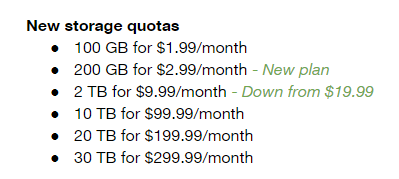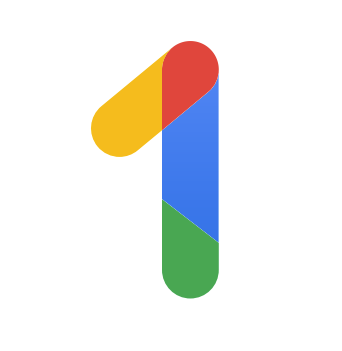Music
Trailers
DailyVideos
India
Pakistan
Afghanistan
Bangladesh
Srilanka
Nepal
Thailand
StockMarket
Business
Technology
Startup
Trending Videos
Coupons
Football
Search
Download App in Playstore
Download App
Best Collections
Technology
Google is revamping its consumer storage plans today by adding a new $2.99/month tier for 200 GB of storage and dropping the price of its 2 TB plan from $19.99/month to $9.99/month (and dropping the $9.99/month 1 TB plan). Italso rebranding these storage plans (but not Google Drive itself) as &Google One.&
Going forward, you&ll also be able to share your storage quota with up to five family members.
 That by itself would be interesting, given how easy it is to max out 100 GB with 4K videos and high-res images these days, but there is one other feature here that explains the new brand name: free one-tap access to Google Experts for help with any Google consumer product and service.
That by itself would be interesting, given how easy it is to max out 100 GB with 4K videos and high-res images these days, but there is one other feature here that explains the new brand name: free one-tap access to Google Experts for help with any Google consumer product and service.
That access to live experts — not some barely functional AI chatbot — comes with every Google One plan, including the $1.99/month 100 GB plan. In the U.S., these experts will be available 24/7 over chat, email and phone. In other countries, this lineup of support options may vary, but the company tells me that its objective is &to provide users with great one-tap support and constantly improve it over time.&
Google already offered 24/7 support for paying business users with a G Suite account, but this is the first time it actively offers live support for consumers.
Itworth stressing that the existing free quota of 15 GB will remain.
In addition to access to experts, the company also promises to provide subscribers with other benefits. Google Onedirector Larissa Fontaine told me that those could include discounts on hotels you find in Google Search, preferred rates for other Google services or credits on Google Play. &We hope to build those out over time,& she noted.
 Brandon Badger, Googlegroup product manager for Google One, told me the team looked at how people use the storage plan. Users now have more devices, shoot more 4K video and share those files with more family members, who in turn also have more devices. &We are looking with this plan to accommodate that,& he said.
Brandon Badger, Googlegroup product manager for Google One, told me the team looked at how people use the storage plan. Users now have more devices, shoot more 4K video and share those files with more family members, who in turn also have more devices. &We are looking with this plan to accommodate that,& he said.
In addition, Fontaine noted that users with paid storage accounts also tend to be heavy Google users in general, so combining storage and support seemed logical.
Sadly, this isn&t an immediate change. Over the course of the next few months, Google will upgrade all existing storage plans to Google One accounts, starting in the U.S., with a global rollout following after that. Google also tells me that it will roll out a new Android app to help users manage their plan (not their files).
While the focus of todayannouncement is on storage, ithard not to look at this new offering in the context of the additional support and other bonus features that Google promises. Google One is clearly about more than simply a better storage plan offering. Instead, it feels like the beginning of a new, more ambitious offering that could be expanded to include other services over time. Maybe a single subscription to all Google consumer services, including Drive, YouTube Red and Play Music (or whatever becomes of that) Despite its name, Google One is currently only one of many subscription services the company offers, after all.
- Details
- Category: Technology
Read more: Say hello to Google One
Write comment (93 Comments)A new tool by researchers at the School of Science at IUPUI and Erasmus MC University Medical Center Rotterdam in the Netherlands can predict your hair, skin, and eye color from your DNA data. The system, which is essentially a web app that can accept DNA sequences, compares known color phenotypes to known data and tells you the probabilities of each color.
The app, called HIrisPlex-S, can tell colors from even small amounts of DNA like that left at a crime scene.
&We have previously provided law enforcement and anthropologists with DNA tools for eye color and for combined eye and hair color, but skin color has been more difficult,& said forensic geneticist Susan Walsh from IUPUI. &Importantly, we are directly predicting actual skin color divided into five subtypes — very pale, pale, intermediate, dark and dark to black & using DNA markers from the genes that determine an individualskin coloration. This is not the same as identifying genetic ancestry. You might say itmore similar to specifying a paint color in a hardware store rather than denoting race or ethnicity. If anyone asks an eyewitness what they saw, the majority of time they mention hair color and skin color. What we are doing is using genetics to take an objective look at what they saw.&
You can actually try the web app here but be warned: itnot exactly the most user friendly app on the web. It requires you to know specific alleles for your test subject or upload a set of alleles in a csv file. It is, however, free and looks like it could wildly useful in law enforcement and figuring out what your hair color was before you dyed it purple.
&With our new HIrisPlex-S system, for the first time, forensic geneticists and genetic anthropologists are able to simultaneously generate eye, hair and skin color information from a DNA sample, including DNA of the low quality and quantity often found in forensic casework and anthropological studies,& said Manfred Kayser of Erasmus MC.
- Details
- Category: Technology
Read more: A free web tool can predict your hair, skin, and eye color from DNA data
Write comment (92 Comments)When Amazon introduced AWS Lambda in 2015, the notion of serverless computing was relatively unknown. It enables developers to deliver software without having to manage a server to do it. Instead, Amazon manages it all and the underlying infrastructure only comes into play when an event triggers a requirement. Today, the company released an app in the iOS App Store called AWS IoT 1-Clickto bring that notion a step further.
The 1-click part of the name may be a bit optimistic, but the app is designed to give developers even quicker access to Lambda event triggers. These are designed specifically for simple single-purpose devices like a badge reader or a button. When you press the button, you could be connected to customer service or maintenance or whatever makes sense for the given scenario.
One particularly good example from Amazon is the Dash Button. These are simple buttons that users push to reorder goods like laundry detergent or toilet paper. Pushing the button connects to the device to the internet via the home or businessWiFi and sends a signal to the vendor to order the product in the pre-configured amount. AWS IoT 1-Click extends this capability to any developers, so long as it is on a supported device.
To use the new feature, you need to enter your existing account information. You configure your WiFi and you can choose from a pre-configured list of devices and Lambda functions for the given device. Supported devices in this early release include AWS IoT Enterprise Button, a commercialized version of the Dash button and the AT-T LTE-M Button.
Once you select a device, you define the project to trigger a Lambda function, or send an SMS or email, as you prefer. Choose Lambda for an event trigger, then touch Next to move to the configuration screen where you configure the trigger action. For instance, if pushing the button triggers a call to IT from the conference room, the trigger would send a page to IT that there was a call for help in the given conference room.
Finally, choose the appropriate Lambda function, which should work correctly based on your configuration information.
All of this obviously requires more than one click and probably involves some testing and reconfiguring to make sure you&ve entered everything correctly, but the idea of having an app to create simple Lambda functions could help people with non-programming background configure buttons with simple functions with some training on the configuration process.
Itworth noting that the service is still in Preview, so you can download the app today, but you have to apply to participate at this time.
- Details
- Category: Technology
Read more: AWS introduces 1-click Lambda functions app for IoT
Write comment (98 Comments)Quite a number of companies — 53, to be exact — have received permits to test self-driving cars with a safety driver in California. One of the more notable companies that has received such a permit is China-based Didi Chuxing, which officially opened its U.S.-based research lab last March.
Also on the list of permit holders is Udacity, which partnered with Didi last year to host a contest for the development of an Automated Safety and Awareness Processing Stack.
In April, the California Department of Motor Vehicles introduced some new regulations and permit application processes for self-driving car companies.The new system entails three autonomous vehicle permit options: testing with a driver, driverless testing and deployment. Most of the new elements of the regulations are around driverless testing and deployment.
For example, in order to conduct driverless testing, companies must have previously tested the vehicles in controlled conditions. The vehicles must also, among many other things, meet the definition of an SAE Level 4 or 5 vehicle.With deployment, companies need to ensure cars can detect and respond to roadway situations, meet best practices to detect cyberattacks and more.
Another notable permit holder is Apple, which in January expanded its fleet to include 27 cars. Missing from the list, unsurprisingly, is Didi rival Uber.
Last week, Uber CEO Dara Khosrowshahi said Uber will bring back its self-driving cars &within the next few months, I don&t know.&
To be fair, Khosrowshahi didn&t sound 100 percent confident in his answer. Thatjust to say I wouldn&t be surprised if it takes Uber longer than a few months. He went on to say that when Uber does bring its cars back on the road, &itgoing to be in as safe of a way as possible.&
Uber pulled its self-driving cars off the roads following a fatal crash in March. Later that month,Uber decided not toreapply for a self-driving car testing permit in California. Uberprevious permit expired March 31.
If Uber wants to continue its tests in California, it will need to apply for a new permit, as well as &address any follow-up analysis or investigations from the recent crash in Arizona,& DMV Deputy Director/Chief Counsel Brian Soublet wrote in a letter to Uber in March. Uber may also need to set up a meeting with the DMV.
I&ve reached out to Didi to learn more about its plans for self-driving cars in California and will update this story if I hear back.
- Details
- Category: Technology
Read more: Didi Chuxing can now test self-driving cars in California
Write comment (97 Comments)Whoever had the over on DraftKings‘ boss Jason Robins and FanDuel chief executive Matt King being given a potential billion-dollar windfall by the Supreme Courtdecision to allows sports betting should head to the cashiercage.
In a six-to-three decision (Justice Breyer was a partial dissent), Supreme Court Justices struck down a federal law that had banned gambling on sporting events in most states.
The implications of this for state tax revenues, and around arguments for making significant changes to the ways college athletes are compensated (or should be compensated), are huge, but clear winners from this ruling are the online betting companies… or any media company that has any sort of exposure to live-streaming sporting events.
DraftKings and FanDuel seem like clear early winners, but really therea market for Facebook, Twitter, YouTube and the major networks that hold sports broadcasting rights to open up new sources of revenue. For the two leaders in online sports betting, the decision is a new lease on life — although both companies had argued that they were games of skill and not chance, and should not be regulated as odds-based gambling companies.
At stake is an industry that NBA commissioner Adam Silver pegged at nearly $400 billion in a New York Times editorial from 2014.
Specifically, the case before the Supreme Court concerned the Professional and Amateur Sports Protection Act of 1992, which outlawed states from approving sports gambling. At the time, the court gave exemptions to states that already held sports lotteries and Nevada — because… well… Nevada. Other states had the opportunity to opt in, but they couldn&t get their acts together in time to approve sports betting in their legislatures.
Mainly, the current court was concerned with whether the law represented an instance of commandeering by the federal government (basically improperly stepping on states& rights). At the heart of the case was New Jersey voters& decision to legalize sports betting in the state in 2011 as revenues from Atlantic Citycasinos (the only places where hopelessness and schadenfreude converge) declined.
The New Jersey decision was challenged by every major American sporting league and the New Jersey law was struck down by the federal courts. When Jersey tried to change the law to make sports betting legal at places where gambling was already permitted, the leagues again swooped in to challenge the law — and they won again.
In the recent Supreme Court decision, the Justices decided that the Federal government could not commandeer states& resources for national purposes.
The ruling MAY also have implications for another industry that has been trying to get on more secure legal footing. Indeed, the (very conservative) New York Post published an op-ed at the end of last year basically arguing in favor of letting states decide on the legality of both gambling and marijuana nationwide.
- Details
- Category: Technology
When Apple introduced its completely redesigned App Store last fall, one of its goals was to improve app discovery by placing a larger emphasis on editorial content & including things like &app of the day& picks, lists, how-toand even interviews with app developers, among other things. Now, a new study from Sensor Tower reveals those changes appear to have been working.
According to Sensor Tower findings, more apps are being discovered by way of browsing the App Store following the redesign launched in September.
Before, browse-driven downloads accounted for around 10 percent of all downloads. With the new App Store, they&ve grown to more than 15 percent. And that increase has held steady into 2018, even as the initial excitement around the App Store revamp has worn off.
Despite the growth in app discovery by browsing, searching for app by typing keywords into the search box is still, by far, the primary way consumers are finding and downloading new apps. Today, search accounts for 65 percent of downloads & well ahead of browse, referrals, or other methods.
Sensor Tower based its findings on data collected on app downloads between May 2017 and April 2018, it says.
The report also delved into the differences between how consumers discover apps and games.
As it turns out, browsing plays a much more significant role in game discovery than it does for non-game apps. Only 56 percent of game downloads came from search, compared with 69 percent for non-games. Meanwhile, browse contributed to 24 percent of game downloads, compared to just 9 percent of non-game downloads.
What this seems to indicate is that iOS users are turning to the App Store and its editorial recommendations in greater numbers to learn about what new game to try next. Plus, the fact that games can now include a video preview, and labels like &EditorChoice& are better highlighted in the new App Store also likely help people get a better sense of which ones to install, as they browse.
Sensor Towerfindings about game downloads line up with research released last month where it found that games that were featured as the &Game of the Day& could see their downloads increase by 802 percent, compared to the week prior to being featured. Apps, by comparison, saw boosts of 685 percent.
The new reportfindings are good news for Apple which had a sizable challenge to tackle with its App Store redesign.Its app marketplace had grown almost over-crowded over the years. And even after the big app cleanup, it still stands at over 2 million apps.Finding a way to better introduce favorites and newcomers to iOS users at this scale was a tall order, but the growth in apps discovered by way of browsing indicates Apple has seen some success on this front.
- Details
- Category: Technology
Read more: Apple’s App Store redesign improved app discovery, report finds
Write comment (91 Comments)Page 5412 of 5614

 15
15















